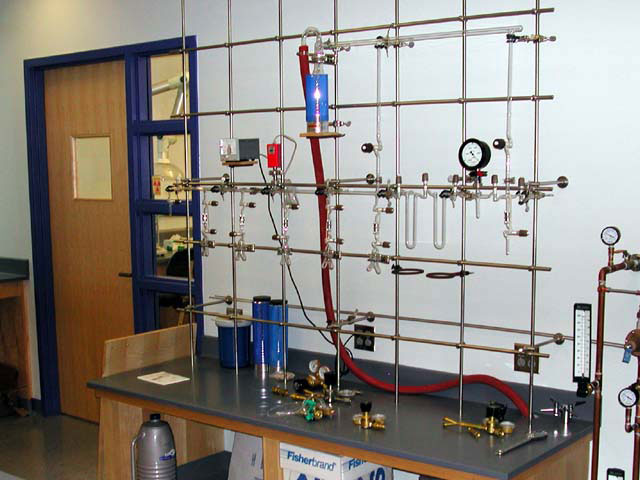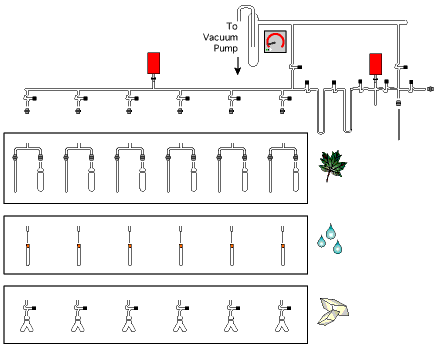Vacuum Preparation Lines for Stable Isotope Analysis
We currently have a couple of modular, multi-purpose sample-preparation vacuum line. We can extract water from plant or soil samples by vacuum-cryogenics, prepare water samples for oxygen isotope analysis by equilibration with CO2, extract CO2 by acid digestion from carbonate minerals for both oxygen and carbon isotope analysis, and combust graphite and organic carbon samples to CO2 for carbon isotope analysis. We are also able to prepare water samples for hydrogen isotope analysis by thermal reaction with zinc metal.

Below is a schematic diagram of one of the vacuum lines showing modules for extracting water from soils and plants, for H2O-CO2 equilibrations, and for reacting carbonates.

We use rotary vane vacuum pumps (Edwards RV3) to evacuate the lines, down to 10-3 torr (or less). We measure the pressure in the line with Edwards Active Pirani gauges, which have a range extending from below 10-3 torr to atmospheric pressure. We fit the pumps with outlet oil mist filters and an inlet foreline traps.
Liquid Nitrogen and a slurry of Dry Ice in ethanol are used to condense gases in the line, moving them from one spot to another, and separating them one from another. Vacuum-insulated dewars in a variety of sizes are used for storing and handling these cryogens. Please read the relevant Warning Labels and Material Safety Data Sheets (MSDS).
We use a Neslab RTE-211D constant temperature bath for controlling the temperature of H2O-CO2 equilibrations and carbonate-acid digestions; and a Thermolyne 48025-80 Programmable Muffle Furnace for annealing glassware, combusting graphite and organic carbon samples, and driving the water-zinc reaction that releases Hydrogen.
A variety of high-pressure compressed gases are used in the laboratory. A fuel-gas/Oxygen torch is used for sealing gas samples in glass ampules and other glass-blowing operations. Nitrogen is used for drying syringes and flushing lines. CO2 is used for H2O-CO2 equilibrations, and to generate Dry Ice "Snow" which is used in an ethanol slush for separation and purification of gas samples on the vacuum line. Please read the relevant Warning Labels and Material Safety Data Sheets (MSDS).
Safety in the Laboratory—Practice Safe Science

website by thorpeallen.net
January 2009
